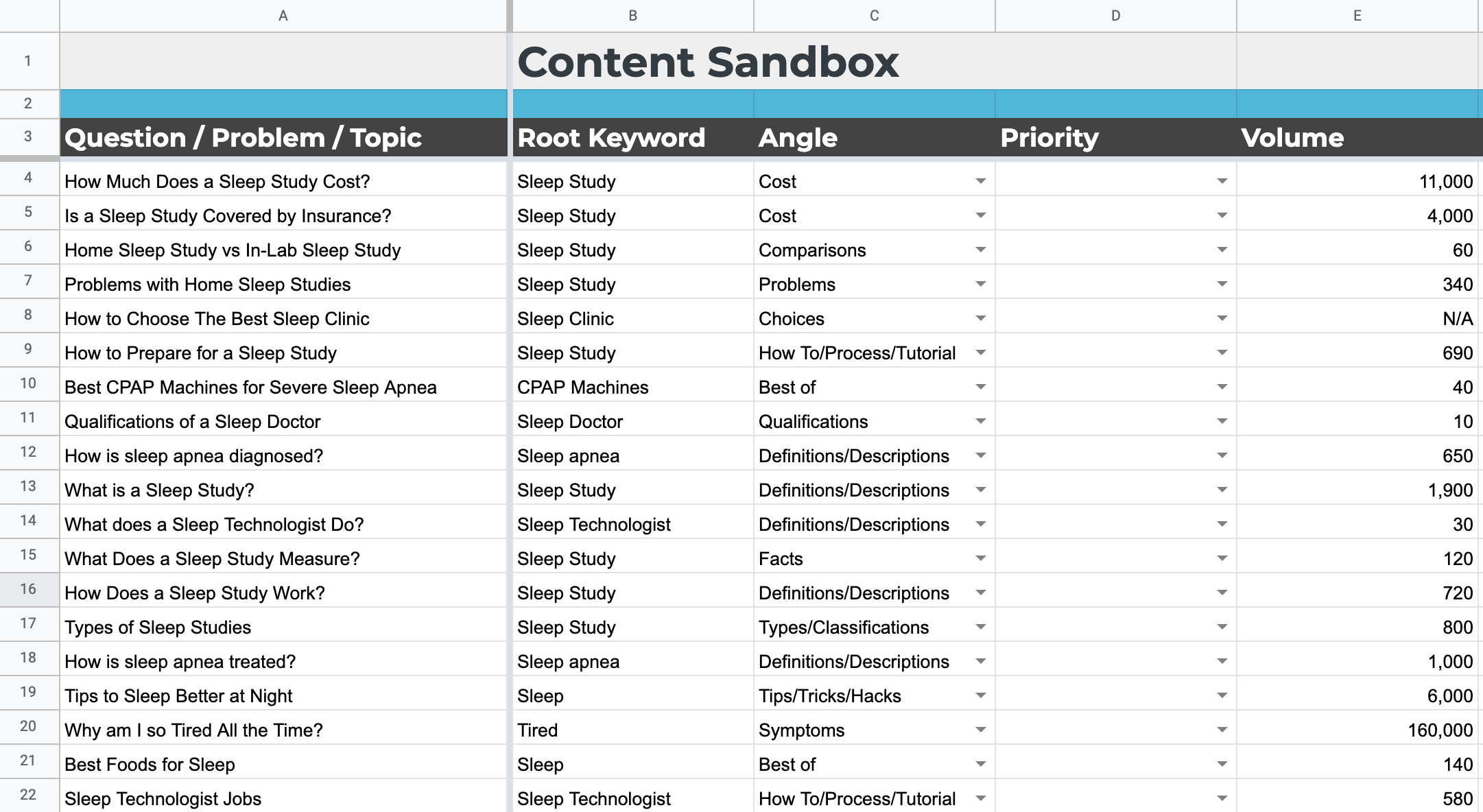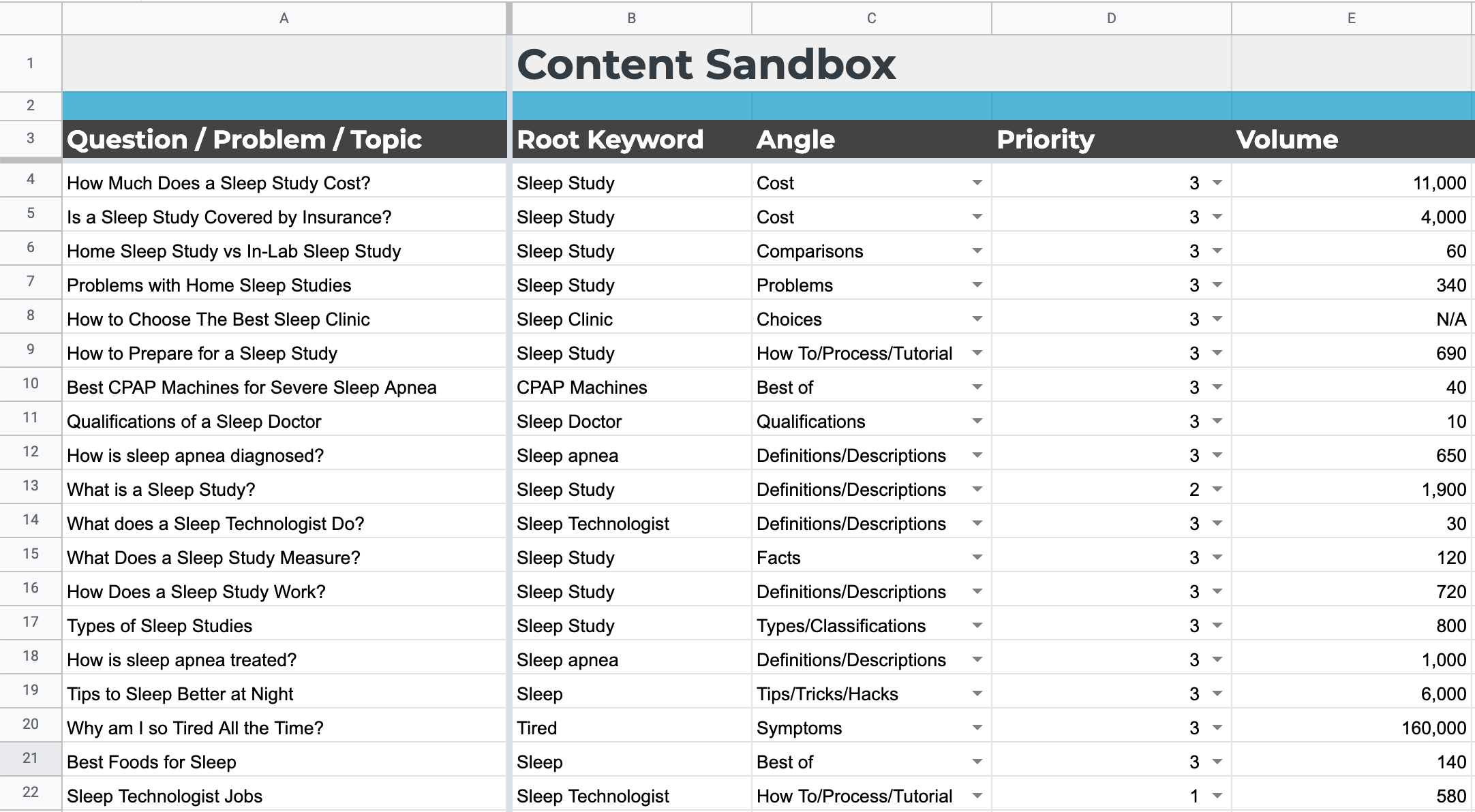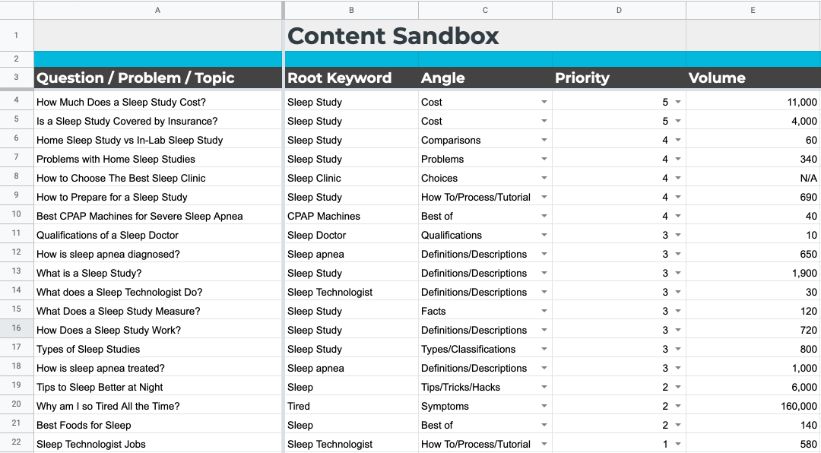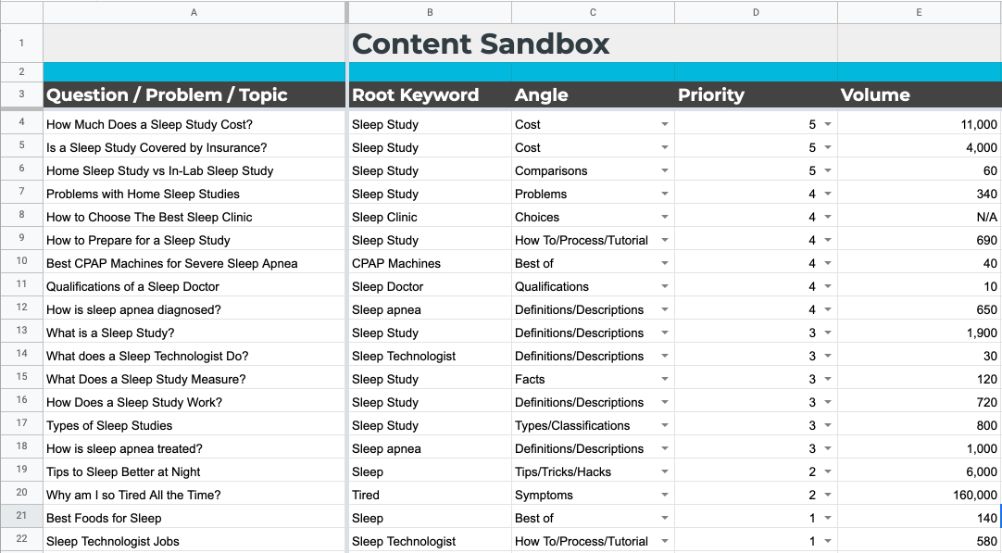How to Prioritize Your Blog Topics & Fine-Tune Your Content Calendar

Are you flooded with blog topic ideas for your business but aren’t sure how to prioritize which to publish first?
This is a common problem I’ve seen from many organizations over the years as businesses try and get their content marketing efforts off of the ground.
Tell me if this sounds familiar: your marketing team has drummed up a wealth of potential blog topics. They’ve met with your sales and customer service teams to uncover the most common questions and pain points your customers and prospects experience.
They’ve used keyword tools like SEMrush, Ahrefs, or Moz to analyze the top keywords in your industry.
Heck, they may have used competitor analysis tools to reveal the topics that currently drive traffic for your competitors.
Your marketing team might be sitting on a mountain of blog topics that could have your business publishing several articles a month for the foreseeable future.
But how do you choose which article topics are the most valuable to publish sooner rather than later?
Well, you’re in luck. Over the past eight years, I’ve had the opportunity to work with over 100 businesses to develop their content strategy.
Together, we combed through topic after topic as we fine-tuned their content calendars. Choosing only the choicest ideas to move forward with. We looked for articles that could have the most impact on traffic, leads, and sales. The articles that met those qualifications got marked to move forward in production.
And through working with all of these companies and picking up on common threads across industries and business types, I’ve developed a list of five questions that can easily determine whether an article should be put into production now, back-burnered for a later date, or even scrapped entirely.
By the end of this article, you’ll know how to use these five questions to run through your Sandbox of ideas and build a robust content calendar that will get you results.
5 Questions That Will Help You Prioritize Your Business Blog Topics
To best help illustrate the following topics, I drafted up a list of 15 potential blog articles a sleep clinic, specializing in diagnosing and treating sleep apnea, may consider writing about.
[Side Note: I got my inbound marketing start as a content manager creating content for a sleep clinic.]

As we go through the list of five questions, I’ll reference my Sandbox to use as an example of how these questions could help organize the publishing order of these blog articles.
These five questions are:
- Who is the article for?
- When are they asking these questions in their buyer’s journey?
- How often are these questions being asked?
- How helpful would these articles be to our sales team?
- How influential are these answers to buyers’ decision-making?
- Is a blog the best format for answering these questions?
1. Relevance: Who is the Article For?
When you’re blogging, you have to know who the articles you’re writing are ultimately for. Sure, it may be a topic that has your targeted keyword in it, but is it tailored to the right audience?
You may find that you have several different types of audiences and personas visiting your website.
You may have competitors reviewing your content, trying to steal great ideas from you, or using your content to educate their own customers.
You may have people looking for work coming to your website for information about breaking into your industry.
You may have people interested in buying your services or products browsing your content as they decide if what you have is the right solution for them.
And heck, you may even have college students looking to cite credible sources for an essay they’re working on surfing your website five hours before their paper is due (I wish I could say I wasn’t guilty of this myself).
While there are good arguments for diversifying your content to different audiences, it’s best to tailor most of your content to prospective buyers. After all, they’re the ones that pay the bills. And if you want them to continue paying your bills, you have to help them make educated buying decisions.
So ask yourself, “is this topic relevant to my buyers?”
If you look at the Content Sandbox I made for the sleep clinic, you’ll see most of those questions do come from prospective customers. However, one question listed is clearly for a different audience.
Can you spot it?
Sleep technologist jobs is not a question someone suffering from sleep apnea would be asking. That query is for people looking to either become sleep technologists or find a list of available sleep tech positions.
Now, maybe your focus this upcoming quarter is recruiting talent, in which case this article is still a good topic to write about. But if your concern is to generate revenue from paying customers, I’d give this one a low priority.
I typically rank the priority of an article on a scale of 1-5.
If this is a question that buyers ask, it’ll start at a three.
If this is a question others in our audience ask, and I currently have no campaigns targeting non-buyers, I’d start off with a one.
Most of the questions on my calendar list would now get a three, while the sleep technologist jobs would start at a one.

2. Timeliness: When are They Asking This Question?
By “when are they asking this question,” I’m referring to when this question comes up during their buyer’s journey.
Whether you’re looking at the buyer’s journey as a funnel or HubSpot’s updated flywheel model, it’s important to know when in the buyer’s journey people are asking this question.
Most businesses make the mistake of focusing on the beginning of the buyer’s journey, the awareness stage.
Most marketers think they should follow the buyer’s journey themselves as they create content.
They start where the buyers start and create content that eventually leads to their final destination—purchasing a product or service.
But I completely disagree with this approach, and here’s why.
If you look at my Content Sandbox, you’ll see that why am I so tired all the time is a question that gets asked roughly 160,000 times every month.
It’s one of the first questions that can take people down a long road of learning. They start with figuring out if their symptoms could be caused by sleep apnea. Many might wonder what sleep apnea is, so they go down that rabbit hole.
Then they start researching long-term complications of the disorder, followed by finding out how it’s diagnosed and treated, and finally decide which sleep clinic they want to diagnose and treat their condition.
And along the way, there are lots of places they can exit the buyer’s journey. Being tired is often the top symptom for most of the 80+ sleep disorders. Their issues could stem from insomnia, restless leg syndrome, narcolepsy, delayed sleep phase syndrome, you name it. It could also be caused by medications, other underlying medical conditions, or just poor sleep hygiene.
In short, the journey from articulating their symptoms in search all the way to scheduling a sleep study with a local clinic can take months to finish.
I actually wrote this blog article once upon a time, way back in 2014. It ranked top of Google for several years and brought in millions of views.
But you know what it didn’t bring in? Revenue. I couldn’t tie this particular article back to a single deal. It had a lot of secondary benefits to writing it, but it never led directly to revenue.
Therefore, if increasing leads and sales are a higher priority than just traffic and backlinks (which I hope they are for you), then you want to focus more of your attention towards the end of their journey.
What are the questions that your customers ask your sales team?
What are they asking your customer service team?
What answers do they need before they’re willing to schedule a consultation or add your product to their shopping cart?
When you catch buyers near the end of their journey first, you’ll see the fruits of your efforts sooner.
Once you do this, then you can backtrack along the journey catching more and more people and guiding them to the right place. You have the next steps already laid out for them.
Looking back at my Sandbox, while I initially would have given why am I so tired all the time a three, this second question either holds it at a three or bumps it back to a two.
Sure, it’s relevant to buyers, but the timeline of when they’d go from this question to scheduling a consultation could take a long time.
Meanwhile, questions like how does a sleep study work and does insurance cover sleep studies are questions that show me people already know sleep apnea is a problem in their life. They know they want it solved, and they’re now looking at the logistics of making it happen.
These would get bumped up to a four.
3. Frequency: How Often Does This Question Get Asked?
Here’s a great litmus test for any article you could write: how often does this question get asked by prospects?
Now, you may be inclined to strictly look at the keyword volume for particular topics. You might be looking at my Sandbox right now and see one like tips for better sleep at night and think, “wow, six thousand searches per month, this one is perfect.”
But take a moment to think that one through. That question could be a buyer’s question, but it could also be an audience question; someone without sleep apnea that just needs tips for a more restful night.
It’s also not found deeper in the buyer’s journey. This is often a question asked early in their journey before they really dive into the symptoms of a problem they’re experiencing and uncover the causes and solutions.
Further, keyword frequency alone doesn’t always tell us that it’s a great topic to write about. Top-of-the-funnel questions typically have higher volumes, so they shouldn’t be given an automatic green light to write about.
Don’t assume that just because a topic is asked often in search, it must be a highly valuable topic. Take a minute and talk with your sales team first.
Ask them this: “when you’re on a sales call, what questions do 80% of prospects ask?”
It’s really that easy to find the best questions when phrased this way.
Who knows your customer’s worries, fears, and pain points quite like your sales teams?
Every day they’re on sales calls with prospects, and they’re fielding the same questions over and over again. And they can quickly tell you the top 10-15 questions they’re likely to get asked by most people.
When the questions they hear are also reflected with high keyword volume, those topics score high points.
Asking how much sleep studies cost and if they’re covered by insurance are two that get searched thousands of times each month.
It’s also the number one question nearly every patient needs to know before they commit to scheduling an appointment.
If these questions passed the first two tests, have high search volumes, and come up frequently with real prospects, score these a five.

4. Usefulness: How Helpful is This Content To Your Sales Team?
Sometimes the questions listed in your Sandbox won’t have high keyword volumes. There’s even a chance you won't find any data on these keywords at all.
Does that disqualify them from the calendar or at least bump them down several points?
Nope. The riches are often found in the niches.
I’ve found some of the most valuable questions to address are the ones people ask your sales team. These are questions specific to your business that people need to know as they determine whether to work with you or a competitor. They might want to know about your pricing, your process, your deliverables, and more.
Once you get the sales team to give you the top questions they hear from most prospects, go back through your list of topics and ask them this important question:
“If we published this article today, could you use it to influence a deal tomorrow?”
If the sales team says they could immediately use the content to send to a prospect to help sway their decision, then these could be very powerful pieces of content.
Content is stronger and more useful when it’s being used as a sales tool to close deals and not just a marketing tool to bring in leads.
5. Impact: How Influential is This Answer to Their Decision?
So far, we’ve talked about making sure buyers are asking these questions, that we prioritize decision and consideration stage content, that our sales teams hear the questions frequently, and that the sales team would actively use the content to help close deals.
You may have several questions now that are scoring 4s and 5s on the priority scale. What is another way you can differentiate them?
Consider how influential the answer to these questions are.
Do the answers to these questions propel people forward in their buying decision? Or are they just “nice to know questions” that don’t have too much influence on their final decision?
For example, the price and insurance questions are critical to the buyer’s decision. If they can’t afford it, they may have to delay purchasing. Home sleep study vs in-lab sleep study can help them decide which option might be best for them.
On the other hand, what does a sleep study measure is a nice detail that gives people a peek behind the curtain, but it’s not going to make or break a deal.
So ask yourself (and your sales team): does this answer give them a gentle nudge or a big shove forward in their decision-making?

Need Help Fine-Tuning Your Marketing Strategy?
So there you have it, five questions guaranteed to help you organize and prioritize topics from your Sandbox so you can answer the most important questions first.
Looking back at my example Sandbox, I’ve run through these five questions with each topic and come up with an organized list.
I’ll begin by producing any topic with a priority level five, then slowly work my way down to the ones and twos. However, as I continue to add questions to my Sandbox, many of these lower-ranked topics may continue to get bumped to the bottom of the pile as more pressing topics come up.
Here at Media Junction, while we love building beautiful HubSpot websites for businesses, we really love helping develop strategies that drive traffic, convert leads, and close deals.
For more information on all things blogging, SEO, inbound marketing, email marketing, and web design tips, subscribe to our blog to stay up to date on digital marketing best practices.
Written by:
Kevin PhillipsMeet Kevin Phillips, your go-to expert for making digital content that gets noticed. With a decade of experience, Kevin has helped over 150 clients with their websites, messaging, and marketing strategies. He won the Impact Success Award in 2017 and holds certifications like Storybrand and They Ask, You Answer. Kevin dives deep into content creation, helping businesses engage customers and increase revenue. Outside of work, he enjoys snowboarding, disc golf, and being a dad to his three kids, blending professional insight with a dash of humor and passion.
Related Topics:



